Semantic SEO Strategy to Boost Your Rankings
January 23, 2024
Neha Bawa
Summary: The new SEO strategy is shifting gears from conventional keyword research to semantic search. Tailored for digital marketers and SEO experts, we’ve crafted a guide that spotlights content depth, user intent, and the dynamic evolution of search algorithms. Learn to craft a robust Semantic SEO strategy that not only boosts rankings but fuels transformational business growth.
Remember the days when stuffing your content with keywords was the OG SEO strategy?
Thankfully, with time Google’s algorithm matured, seeking a better understanding of the human language and its relevance to the readers.
Marketers who have already leveraged the use of Semantic SEO are reaping the benefits of better search engine rankings and high CTRs.
In this blog post, we’ll unravel the secrets of Semantic SEO and show you how to make your content stand out to Google. We’ll also explore some key things Google looks for to understand your content better, like connections between your topics and ideas.
What is Semantic SEO?
Search engines are like super-smart detectives trying to understand what people mean when they type in searches. Semantic SEO is about helping those detectives connect the dots.
It understands the connection between words, meanings, and topics, so it can deliver the most satisfying answers.
Instead of stuffing with keywords, Semantic signals create content that’s rich in meaning, connections, and context. It’s like giving the detective a full story with characters, events, and relationships.
For instance, a website about guitars might repeat the word “guitar” over and over.
A website with a semantic search would cover topics like different types of guitars, how to play them, famous guitarists, guitar brands, and other related topics.
How Semantic SEO is different from Traditional SEO?
Human-like and semantic approach differs from regular SEO primarily in its approach to understanding and presenting content to search engines. Old-school SEO often focuses on specific keywords and optimizing content to match those keywords to rank higher in search results.
Content for Semantic SEO, on the other hand, goes beyond individual keywords and emphasizes understanding the context, intent, and meaning behind user queries.
You can better understand the difference with the table below:
| Aspect |
Traditional SEO |
Semantic SEO |
| Keyword Focus |
Emphasis on specific targeted keywords. |
Focuses on broader semantic keywords and relevant search results. |
| Content Optimization |
Optimizing content for exact keyword matches. |
Optimizing content for meaning and context, and user intent beyond specific keywords. |
| User Intent |
Less consideration for user intent and context. |
Semantic SEO important for understanding user intent and the context behind search queries. |
| Content Depth |
Often limited to keyword-focused content. |
Focuses on providing comprehensive, in-depth content that thoroughly covers a topic or specific search. |
| Search Result Focus |
Primarily aims for higher rankings based on keyword matches. |
Semantic SEO improves rankings by understanding and addressing user needs and intent. Good for local SEO. |
The Evolution of SEO
- Pre-2012: The “keyword stuffing” era, where websites crammed pages with irrelevant keywords to trick search engines.
- Google Knowledge Graph in 2012: Introduced a network of entities and relationships, allowing search engines to understand the real world and the context behind searches. Our blog on the role of knowledge graphs in search engines will help you understand their importance in search engine optimization.
- Hummingbird in 2013: Emphasized understanding the meaning and intent behind search queries, marking a shift towards semantic understanding.
- RankBrain in 2015: A machine learning algorithm that considers user engagement and other factors beyond keywords to assess a page’s relevance.
- BERT in 2018: A powerful natural language processing (NLP) model that further improved Google’s ability to better understand the meaning of search queries and natural language.
Importance of Semantic Search
The rise of AI and NLP has transformed SEO, making semantic SEO strategies more crucial than ever.
Here are some eye-opening stats that showcase the power of semantic SEO:
- The Rise in Voice Search Boom: According to the Search Engine Journal, over 50% of all online searches will be conducted via voice by 2025. This emphasizes the need for voice search optimization of content that understands natural language and user search intent, key aspects of semantic search.
- Zero-Click Searches: 60% of Google searches now result in zero clicks, meaning users find the answer they need directly on the search engine results page (SERP). (Source: Backlinko) To stand out in such a competitive space, websites need content rich in relevant entities and relationships, allowing search engines to accurately represent their value.
- Long-Tail Keywords Reign: 92% of search queries are now long-tail (4 words and more), indicating users are searching for specific information. (Source: Ahrefs) Semantic search thrives on catering to these specific needs by using related keywords, synonyms, and topical depth.
- Content Marketing Wins: Companies that prioritize content marketing see 6 times higher conversion rates. (Source: HubSpot) This highlights the importance of creating valuable, informative content that resonates with users, a core principle of semantic indexing.
- E-E-A-T Matters: Google’s E-E-A-T (Experience, Expertise, Authoritativeness, and Trustworthiness) guidelines hold significant weight in ranking algorithms. Semantic SEO practices like using structured data, citing sources, and building topical authority all contribute to establishing E-E-A-T.
70% of marketers believe that understanding user intent is the most important aspect for search engines and users. Semantic SEO is all about understanding user intent and providing the best possible answer, making it a valuable SEO tool for marketers.
Business Benefits of Semantic Related Search
Business Benefits of Semantic SEO and Google Ranking:
- Increased Organic Rankings: By creating content that truly resonates with user intent and search engine algorithms, semantic markup naturally elevates your organic search rankings. This means more potential customers find your website through relevant searches.
- Enhanced Content Quality: Semantic search SEO encourages creating informative, engaging content that provides value to users. This signals Google crawlers that your website is a trustworthy source of information, strengthening your content quality score and further boosting your ranking potential.
- Brand Authority and Expertise: Semantic SEO practices like citing sources, demonstrating expertise through topical coverage, and utilizing structured data help establish your brand as a reliable authority in your field. This builds trust with users and search engines alike, attracting more visitors and improving conversions.
- Targeted Internal Linking: Semantic search algorithms encourage relevant internal linking that connects related topics within your website. This not only improves user experience but also helps search engines understand the overall structure and thematic coherence of your content, potentially boosting your site’s authority on specific topics.
- Engaging Users and Reducing Bounce Rates: When users find content that precisely addresses their search intent, they’re more likely to stay engaged and explore further. This reduces bounce rates and increases time spent on your website, which sends positive signals to search engines and can positively impact your rankings.
Semantic SEO Strategy for High Rankings
The key pillars of a winning semantic SEO strategy for 2024 are:
1. Understand Your Audience and Their Intent
- Who are you trying to reach?
- What are their needs, pain points, and interests?
- What questions your audience is asking?
All these questions set the foundation for your content strategy. Once, you’re clear on what can intrigue your audience to visit your website and read your content, all that is left is the execution part. There are various SEO tools for comprehensive keyword research and understanding customer search intent. Use these research tools to identify long-tail keywords and search queries related to your topic.
Analyze user behavior with the help of tools like Google Analytics and Hotjar, which can help you understand how users interact with your website and content.
Follow the process to do it:
1. Open Google Analytics Keywords planner.
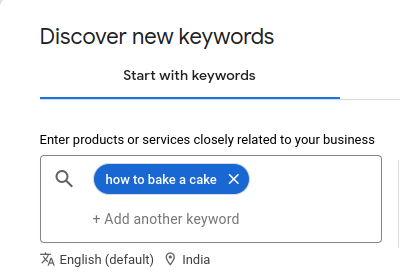
2. Type in your keywords in the search bar. Let’s say ‘how to bake a cake at home’
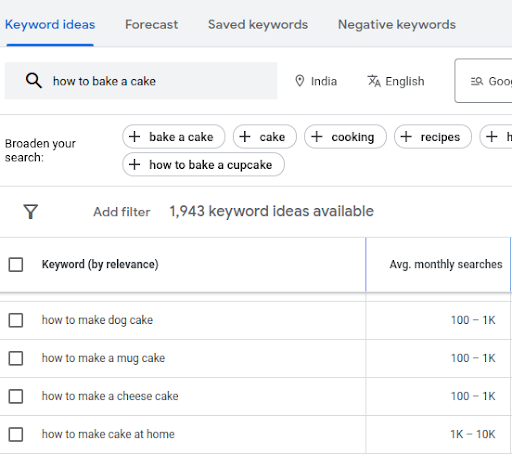
3. Click on Get Results. You’ll get a bunch of long-tail keywords for your asked query. Here you can see keywords like ‘how to make a dog cake, how to make a cheese cake’ etc are the top search for the related terms you entered.
4. Analyze these keywords based on the search volume and keyword difficulty.
5. Pick the best one out and create SEO content for the same.
2. Create Comprehensive and Informative Content
It’s time to go beyond keywords and focus on creating content that is topically relevant and answers user questions in depth.
For that, you can use related keywords and synonyms in the content smartly. Make the language easy to understand and reader-friendly. Answer everything a reader might need to know about that topic.
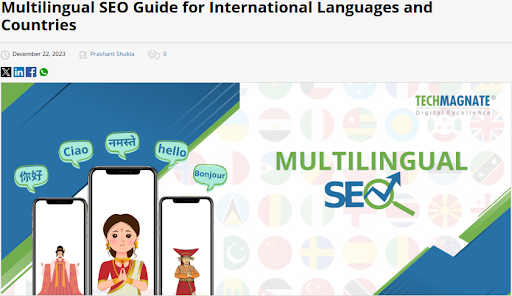
A comprehensive guide helps search engines understand the context of your content and connect it to relevant searches. A very important factor in the context of semantic SEO.
Additional read: A Guide on Multilingual SEO
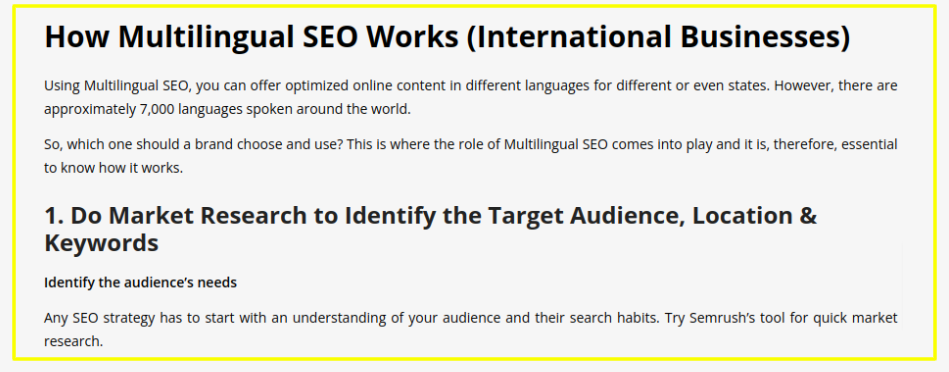
Structure your content logically – use headings, subheadings, and bullet points to make your content easy to read and navigate. This is also a part of technical SEO for your website.
3. Optimize for Google’s Knowledge Graph
Bullet points, sub-heads, reviews, – all these come under the structured data format. Structured data is like giving labels to different parts of your content. So when a query is typed, semantic SEO allows search engines to understand which part of the content to show.
When you include links to trusted sources, like experts’ studies or well-known facts, it makes your content more believable. Lastly, making sure your content covers a topic well—like explaining everything about healthy eating for losing weight—helps people understand it better and makes your website a go-to place for reliable information.
For example, if you’re writing about ‘A recipe for tomato soup,’ using structured labels helps search engines understand sections like ingredients required, cooking time, meal plans, and side dishes to encourage people to check out more easy-to-make recipes.
4. Optimize for Multiple Keywords
In 2024, if you’re still focusing on just one primary keyword, you’re missing out on major traffic. Semantic search engine optimization revolves around using a variety of related terms and phrases that convey the same meaning as your main keyword.
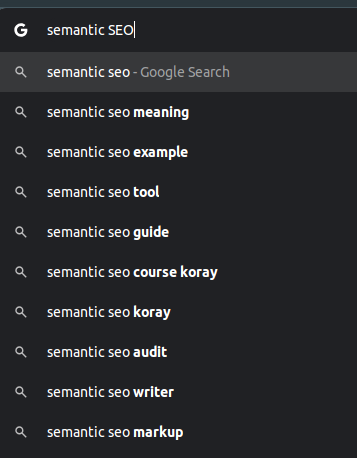
By incorporating this list of semantic keywords naturally throughout your content, you signal to Google and other search engines that your content covers a broader spectrum of topics related to the main subject.
Keyword optimization is an important on-page SEO that not only improves the relevance of your content but also enhances its visibility to a wider range of search queries.
5. Answer People Also Ask Questions
The “People Also Ask” (PAA) feature in search results presents an incredible opportunity to optimize for semantic search.

These questions often revolve around the main topic, providing a chance to create concise, informative content that directly answers a specific search intent.
By incorporating these PAA questions into your content and providing detailed, relevant answers, you increase the chances of your content being showcased in these featured snippets, thereby enhancing visibility and credibility.
6. Follow Topic Clustering
Topic clustering involves organizing content into clusters based on related subtopics or themes. This semantic strategy helps search engines like Google to understand the depth of your content on a particular subject.

Image source: AnswerThePublic
By interlinking content within these clusters, you create a web of interconnected information that signals to search engines the authority and comprehensiveness of your content on a specific topic.
Semantic SEO is the process of providing structured content and strengthening your website’s overall SEO performance by showcasing your expertise in a particular niche.
7. Embrace AI and Natural Language Processing
AI and NLP (Natural Language Processing) in content creation involving using smart tools that understand language patterns and help improve your writing. AI-powered tools like ChatGPT, and Bard can highlight important words and phrases. It also ensures your writing is easy to read and covers all the necessary topics.
Staying updated on the latest advancements in NLP is crucial because search engine algorithms, like Google’s, are always changing. Keeping track of these SEO trends helps ensure that your content stays relevant and visible to the right audience.
For example, when writing about ‘Healthy Meal Planning,’ using AI-powered tools can identify key terms like ‘balanced diet,’ ‘nutrient-rich foods,’ and ‘portion control,’ making your content for semantic search more understandable.
Staying informed about the latest NLP trends allows you to adapt your content to match how people are searching for information about healthy eating habits, keeping your content for search valuable and up-to-date.
8. Track and Analyze Your Results
Keeping an eye on your website’s performance is crucial. Tools like Google Search Console and SEMrush help track how well your site is doing and where you can make it better. Look closely at how users are interacting with your content—metrics like bounce rate (when people leave your site quickly), time spent on pages, and how often people click through to other pages. This tells you if people are finding what they need or if something needs fixing.
Based on this information, keep adjusting your content and SEO strategy to improve the semantics of your site.
For instance, using Google Search Console and SEMrush helps you see if your ‘Healthy Eating Tips’ page is getting a lot of clicks but visitors aren’t staying long. Analyzing these metrics might reveal that adding more visuals or breaking down information into smaller sections can improve user engagement. Continuously adapting your content based on these insights helps maintain a website that people find useful and engaging.
By implementing these strategies focus on semantic search and semantic SEO to achieve higher rankings, attract more qualified traffic, and ultimately, grow your business.
Remember, use semantic SEO best practices to focus on building a strong foundation of entity SEO.
Hope this semantic SEO guide will help your SEO optimization process seamlessly!
Semantic Search Experience in SEO and Digital Marketing
Semantic SEO’s pivotal role in modern digital marketing is shifting from keyword-centric approaches to contextual understanding and relevance. It highlights the transformative milestones in SEO evolution and emphasizes the power of Semantic SEO in enhancing rankings, content quality, and brand authority.
Crafting a successful Semantic SEO strategy for 2024 involves understanding audience intent, creating comprehensive content, leveraging AI and NLP, and continually refining strategies based on data-driven insights.
If you need help with the application of semantic SEO and semantic content, reach out to us. We’d be happy to assist you.